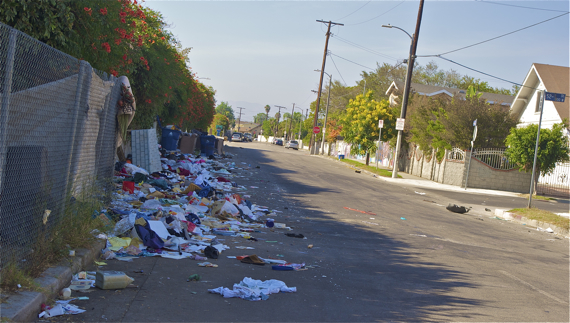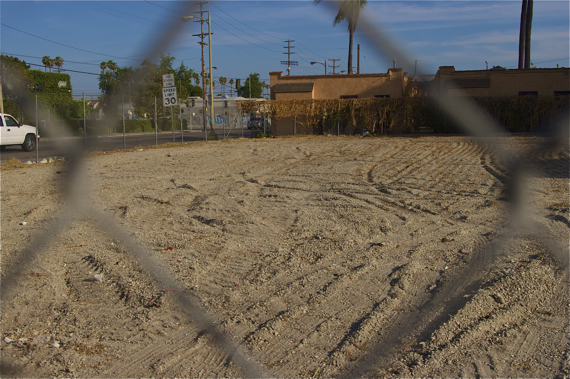
I'm feeling sorta trashy.
Not in that way.
I've just had trash on the brain lately.
Even as L.A. is celebrated for moving toward being more walkable and livable, trash seems to be the one constant, particularly in lower-income areas.
One of the reasons is that there is a lot of dead space in places like South L.A.
Vacant lots, alleys, under- and overpasses, foreclosed homes/properties, and streets running alongside freeways all lack someone to watch over and take responsibility for them on a regular basis.
Which means we get this:

Piles of random clothing, instruction manuals for jurassic technology, handwritten correspondence from the 90s, and issues of the National Enquirer dating back over a decade.
All piled up on the overpass the corner of 52nd and Broadway.
The mess stretches the entire overpass, actually.

It's on the north side of the overpass, too.

And, it's around the corner, all up and down Grand, the street running along the east side of the freeway.


Many of these sites have been this way for years.
The situation is frustrating for residents, who are unsure who to complain to and, after so many years of the same old same old, are resigned to the notion that their complaints will go unheard.
Sadly, they almost accept that trash accumulation and dumping is the norm when freeways cut through their neighborhoods because it is so commonplace.
They don't like it, of course -- to most, it is symbolic of the city's neglect of their communities.
But, it is the blight created by vacant lots that really makes them angry.
The lots, they understand, are owned by somebody, somewhere, and that somebody never seems to be held accountable for the mess their property attracts.
Which is why I was surprised to see a Notice of Abatement tacked to the chain link fence of a consistently problematic lot at 41st and Main in South L.A. a few weeks ago.

The notice reads that, in January, a resolution was passed declaring that noxious or dangerous weeds, rubbish, refuse, and dirt were on or around this property, constituting a public nuisance. It further states that the owner is therefore required to clean up the property or reimburse the city for conducting the abatement on their behalf (via a lien placed on the property tax bill).
The notice took me by surprise because I am one of many advocates who have complained about the challenge communities have faced in figuring out who owns the land or reaching out to the owners, either to get them to take care of it or to work out agreements that would allow the community to use it.
Was getting a lot cleaned up as easy as posting a notice of abatement?
Eh, not so much.
According to the Lot Cleaning Division, undeveloped parcels are subject to being on the city's Annual Weed Abatement Ordinance list. It doesn't mean that all are asked to clean up every year -- in 2012, for example, only 601 of the 10,777 parcels on the list were abated. Nor does it mean that there is a good way to track owner compliance with abatement requests. The city itself doesn't track compliance, citing the potential for ownership change, improvements to a parcel, changes in the Assessor's map, etc., to distort the data.
Technically, parcels that are especially problematic can also be hit with an additional "Notice to Clean," to ensure that they are in compliance throughout the year.
That would assume, among other things, that a lot received a high volume of complaints.
But, tracking complaints isn’t all that simple, either.
Neighbors along 41st St., for example, claim they have complained numerous times over the years to their council district office and other city agencies. And, yet, according to the Bureau of Street Services records’ there have been only six cleanup requests since 2005 – one of which I would assume had to have been mine from earlier this year.
When I asked the media rep why the rest of the complaints – or any others lodged in the past nine years – might not have reached BSS, he clarified that the system had logged a total of twenty-eight requests during that period, six of which were for illegal dumping and/or cleaning. It is unclear what the other requests were for (they went unrecorded, as they fell outside of the BSS’ purview) or why complaints made to other city offices never reached BSS.
What is clear is that putting the burden of watching over vacant lots on residents is unfair, particularly when so many properties are such obvious and persistent sources of blight.
It is also clear that annual assessments (if they are even conducted that frequently) are not enough, either.
The recent abatement conducted at 41st and Main, for example, might have resulted in a lot devoid of weeds, but the lot itself still acts as a magnet for dumpers.

Across the street (barely visible at left, above), a mattress lies in the street. And, the parkways of 41st Place (the next street south of 41st St.) are regularly packed with broken-down furniture.
And, of course, the adjacent sidewalks still attract dumping (this time, including shattered glass).

The fact that not all lots are targeted for abatement or regular cleanups doesn’t seem to make much sense, either (outside of the obvious bureaucratic budget and staff shortfalls, that is).
The long-standing lots just north of Manchester at Vermont are consistently in terrible shape. This former swap meet site is populated with furniture, other bulky items, and scattered trash.

Here, it spills onto the sidewalk.

It’s not like these lots are invisible – the two block-length lots pictured above and below sit across the street from Mark Ridley-Thomas’ Constituent Center, and seem no better off for it than most.
The one below even plays host to a lone inhabitant, who has set up camp just out of the frame.

A lot at Figueroa and 52nd also has its own encampment.

Some attract hazardous waste, dumped by those who clearly didn’t want to pay landfill or hazardous waste disposal fees.


Some lots attract other unhealthy forms of activity.
A lot at 67th and Figueroa, for example, played host to four prostitutes at 4 o’clock in the afternoon.
A few blocks north of there, a (potentially) abandoned house and lot acts as a draw for both dumped furniture and prostitution, judging by the used condoms and empty condom boxes scattered on the ground around it.

Surely we can do better by neighborhoods than this, right?
If we must put the burden on residents to report problems with a lot, why not raise fines for non-maintenance and put some of those funds toward hiring local youth or neighbors to assist with monitoring and reporting?
Or, simply require more regular cleanups and monitoring of the lots by owners so as to curb the illegal activities they attract.
Or, take the steps San Francisco may be making toward creating an ordinance that would allow for the implementation of AB 551 – a bill that cuts developers some tax breaks if they allow the community to use the lot for urban agriculture during a period of five years. That could both activate the lots and limit illegal activity in one fell swoop.
At the very least, the city could post placards on lots with information about how to use the 311 system to report dumping. As I’ve noted here before, my experience is that a very small minority of people in the area are aware that the system even exists. Signs posted at the sites would give people an outlet for their frustration in the moment that they come across a problem. And, it might help the city create a more accurate record of just how problematic vacant properties can be, which would, in turn, justify the placement of more stringent maintenance requirements on property owners.
Whatever the solution, it is time to see the burden of maintaining these properties transferred back to the shoulders of those that own them. They are the ones benefiting from a minimal tax burden while watching the value of their land grow. Keeping the lots clean, healthy, safe, and even beautiful, would seem to be the very least they could offer the community in return.






